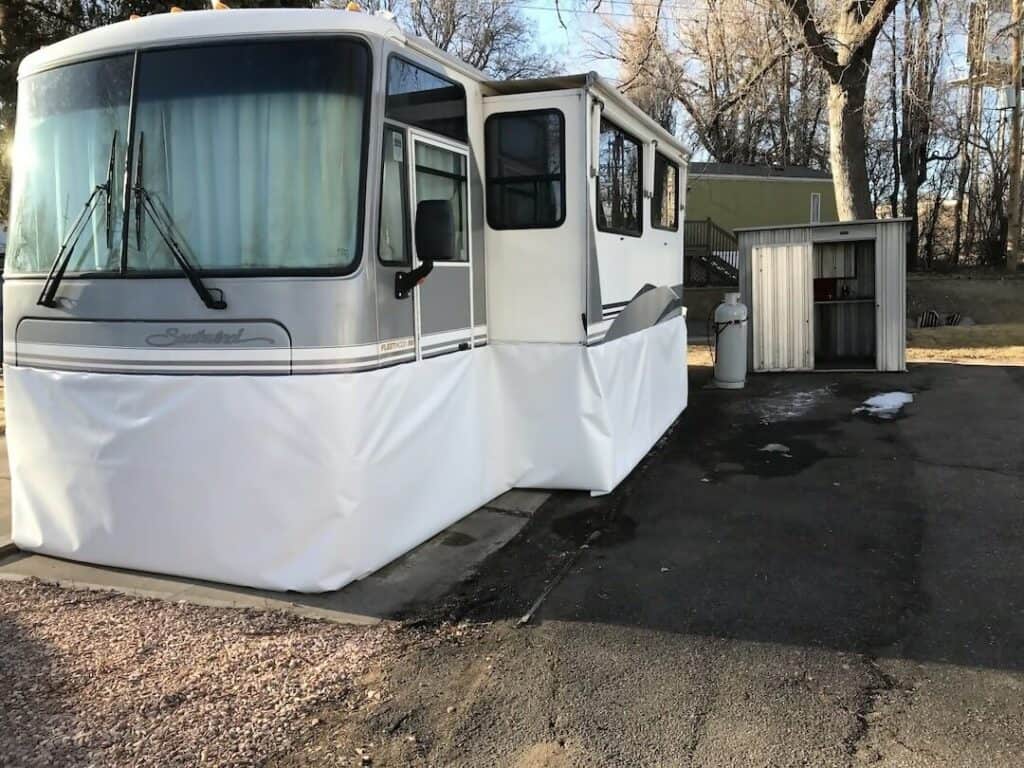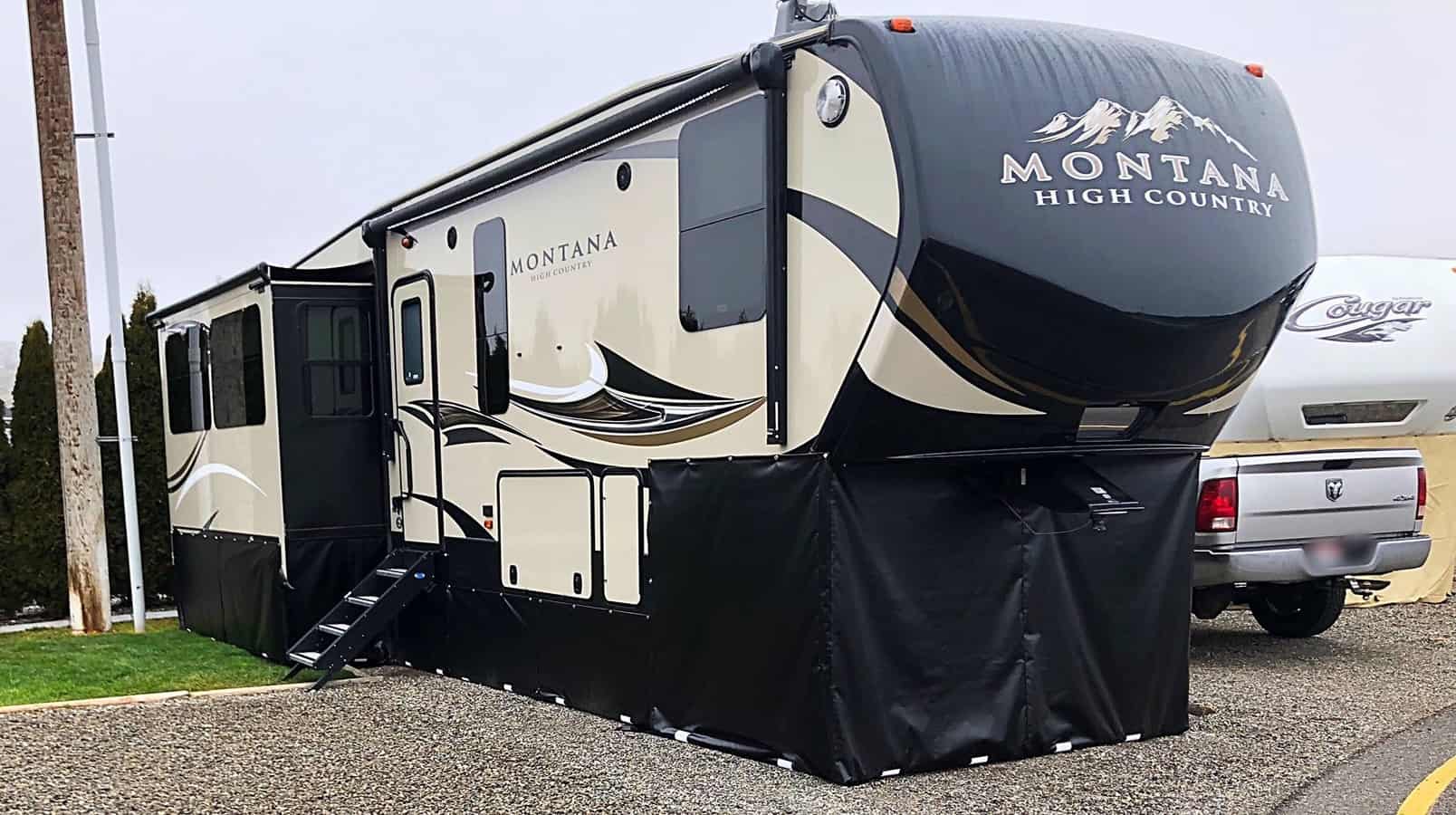
Does RV Skirting Help In The Summer?
Most of us associate RV skirting with helping keep an RV warm in the cold winter months. Picture large insulated panels surrounding the bottom of RVs to hold heat in under the floors and keep the cold air out.
So, can RV skirting help in the summer? The short answer is yes, but let’s take a closer look at the benefits of RV skirting being used year-round.
How does RV skirting work?
Similar to winter, the summer temperature difference between the inside of your RV and the outside can vary greatly. Keeping an RV cool in the summer can be as difficult as keeping it warm in the winter. So why do we only use skirting in the colder months?
There are professional thermal engineers that study for years to become experts, however, for the context of this article, we will keep it simple. An insulation barrier between two areas will deflect temperature from both sides. In the scenario of RV skirting in the summer, the hot temperature and air outside are deflected from entering under your RV and likewise, the cooler temperature and air under your RV are deflected from going outside. The reverse is of course true when you have colder outdoor temperatures.
Insulation, whether it is in the walls of your house, the underneath of your RV, or the wool on a sheep’s back, works the same against cold and heat. You want to keep warm air in, use insulation; you want to keep warm air out, use insulation.

Benefits of using skirting in the summer
When you are RVing in hot weather, the walls and roof of your RV, which are all insulated, are performing the job of keeping the hot air outside and cool air inside. The floor of most RVs also has insulation, meaning your skirting is an additional barrier and layer of insulation.
Think about the heat of asphalt in the summer. Now consider you are in a park where your RV is surrounded by asphalt. Some of this heat will inevitably be directed up under your RV.
Even with the underneath of your RV shaded, the outdoor temperature will still likely be higher than your indoor temperature. This cooler temperature inside your RV can escape and the warmer outdoor temperature can warm up the air under your RV.
The one major benefit of skirting is the reduction in temperature exchange. This means less energy needed to maintain your indoor temperature.
In most cases, the electricity will be included in your site fee so cost may not be considered here. The run time and wear on your air conditioners should be. Possibly extending the life of your air conditioner along with not having to listen to it continually run are all pluses.
Why don’t more people use skirting in the summer?
So there are benefits to using RV skirting in the summer. The main one being the potential reduction in temperature exchange as mentioned above. It’s not common to see RVs with skirting in the summer months, however, and there are a couple of reasons why.
RV skirting can be a pain to install, remove, and store. That is why the main use of RV skirting is by people who are RVing for extended periods in colder climates. If you are pulling into a campsite for the weekend or even a week, it isn’t very likely you are going to install skirting and pack it all up again in a few days.
Many campgrounds do not allow skirting. One exception being campgrounds that have full-time sites and campgrounds that are open year-round in a colder climate. In this case, RVers often can install skirting between certain months.
Skirting to surround a smaller RV takes up a considerable amount of space and is not practical to travel with. When you get to a site, there are already lots of things to do to set up. Installing RV skirting is not something you want to be doing while everyone else is roasting marshmallows.
Types of RV skirting
If you do decide to use RV skirting you will have a few options. A few different materials are used and they can be attached in multiple ways. The most common style is insulated panels wrapped with vinyl material. Usually, fastening is with metal snaps or twist and lock style fasteners.
Some skirting consists of only heavy vinyl and is often used in areas where the temperatures don’t get really cold. This style of skirting takes up considerably less room than the insulated stuff Any material that has some insulating properties can be used. RVers have used wood, foam board, and hay bails to skirt their RVs and they all will do the trick. Whatever the style of RV skirting, they all perform the same task, insulating the area under your RV from the outside temperature and elements.
Another option from AirSkirts has recently been introduced in the form of inflatable skirting to allow for quick set-up with no modifications needed to your RV.
The most practical use of RV skirting is most definitely for longer stays in a single location or places where there will be considerable temperature differences between the outdoor temperatures and a comfortable temperature inside your RV.
Who should consider RV skirting for summer use? Do you have your RV on a piece of property or spend extended periods boondocking where the skirting will not be an issue for campground owners? Maybe you are seasonally at an RV park that allows skirting. If so, it is worth considering having RV skirting for use not only in the cooler months but for summer as well.
One of the best parts about RVing is engaging with the community of traveling enthusiasts. iRV2 forums allow folks to chat with other RVers online, and get other perspectives on everything RVing, including products, destinations, RV mods, and much more.
Continue reading:





If you’re not planning to move the RV, why go to the trouble of removing the skirting, just to put it back up for the next winter? Might as well leave it in place and avoid some extra work.
It seems like a good idea if you are staying in one place for a month or so. Perhaps it also keeps the furry animals out from underside the RV. However, I have seen several RV’s where the dogs sleep under the RV, or chairs are stored underneith.
I have a skirting system for the winter months but as soon as I can I will remove the skirting to prevent insects (especially ANTS) from using it as a ladder. This way you only have to maintain your contact points (tires, jacks, hoses, cords) with an insect repellant. I like to use food grade diatomaceous earth. Its environmentally friendly.
Why don’t more people use skirting in the summer? I think this part of the article is correct but incomplete. Here are my 6-pens. In summer, Utah or Arizona heats in average at 90 degree daytime , and 75-80 at night. We keep 75 inside with average difference of 15 degree during the day, or almost nothing at night, and we do not bother with skirting. At winter, at Breckenridge, Colorado ski resort, we keep 65 degree inside with 0 to negative 15 at night outside, and 80 degree difference will make skirting a must.
Two other considerations favoring winter skirting: In winter, it’s not just the comfort, but preventing pipes from freezing. Also in winter, the difference between indoor and outdoor temperatures can be 50° or more, whereas in summer it’s only going to be 20° or less, and mainly at mid-day. (And heat flow is proportional to the difference in temperature.)
Skirt in winter, ShadeRV.com in summer would seem to make sense.